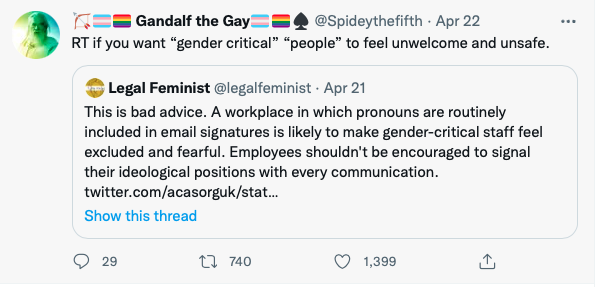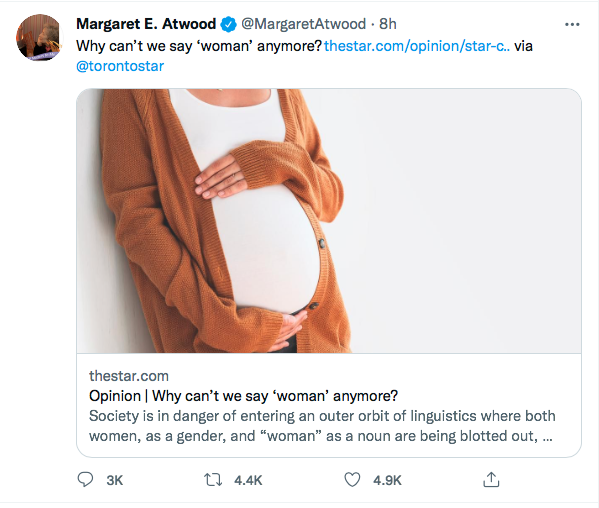A significant step forward in its guidance on ‘Trans People’, but a long way still to go
A Guest Blog By Maureen OHara. She is a legal academic and former solicitor, who is doing research into the impact on women’s rights of the adoption of gender identity theory by criminal justice agencies
In December 2021 a new interim version of the Judicial College’s Equal Treatment Bench Book (ETBB) was published. Its guidance on ‘Trans People’ in chapter 12 includes significant amendments which take account of some of the criticisms of earlier versions made by gender critical feminists and lawyers.
These criticisms relate to broadly four areas, which are compulsion in relation to the use of the preferred pronouns and modes of address of trans-identifying parties to court proceedings; the adoption of tenets of gender identity theory as if they were fact; the implementation of self- definition of ‘gender identity’ in court proceedings; and the lack of transparency about who contributes to the ETBB’s content. Some of these criticisms have been partially addressed in the new version of the ETBB, while others have not.
In August 2021 a group of practising lawyers and legal academics wrote to the Lord Chief Justice expressing concerns about the previous ETBB guidance. The Lord Chief Justice passed our letter to the ETBB’s Editorial Panel for consideration. The text of the letter set out below. Some signatories’ names have been removed because they did not want them made public.
The revised version of the ETBB has taken on board some of the concerns the letter raised, particularly in relation to the treatment of witnesses giving evidence about their experiences of sexual and domestic violence.
In relation to the use of preferred pronouns, the previous version of the ETBB, published in February 2021, stated:
‘‘It is important to respect a person’s gender identity by using appropriate terms of address, names and pronouns. Everyone is entitled to respect for their gender identity, private life and personal dignity.’’ (p. 325)
Neither the February 2021 version of the ETBB nor previous versions which included this requirement, provided any guidance about how it should be implemented in practice in relation to witnesses other than those who identify as transgender, or about how judges should treat witnesses who perceive defendants in terms of their sex rather than their ‘gender identity’.
Some judges interpreted the guidance as requiring them to compel witnesses to use the preferred pronouns of defendants and other parties to proceedings who identify as transgender. This had particularly serious implications for witnesses who were giving evidence about traumatic events, such as being subjected to physical and sexual violence. Previous versions of ETBB did not address the impact on these witnesses of being required to describe a defendant in criminal proceedings, or an alleged perpetrator of domestic abuse in family proceedings, in ways which amount to a denial of their own perceptions of reality. The potential impact of the earlier guidance on complainants in criminal trials is discussed in this journal article which I wrote in 2019.
This account of being instructed by a judge to use a defendant’s preferred pronouns was given by Maria MacLachlan, who was assaulted in 2017. One of her attackers, Tara Wolf, who self-defined as a ‘trans woman’, was convicted of assault by beating in April 2018.
The revised ETBB recognises for the first time that witnesses have a right to refer to trans-identifying people using pronouns which align with their biological sex, and acknowledges that there may be circumstances where this is required by the interests of justice.
Paragraph 26 of chapter 12 states,
“There may be situations where the rights of a witness to refer to a trans person by pronouns matching their gender assigned at birth, or to otherwise reveal a person’s trans status, clash with the trans person’s right to privacy. It is important to identify such potential difficulties in advance, preferably at a case management [1] stage, but otherwise at the outset of the hearing. A decision would then have to be made regarding how to proceed, bearing in mind factors such as:
…Why the witness is unwilling or unable to give evidence in a way which maintains the trans person’s privacy. For example, a victim of domestic abuse or sexual violence at the hands of a trans person may understandably describe the alleged perpetrator and use pronouns consistent with their gender assigned at birth because that is in accordance with the victim’s experience and perception of the events. Artificial steps such as requiring a victim to modify his/her language to disguise this risks interfering with his/her ability to give evidence of a traumatic event.”
There will be occasions when, after these and other relevant factors have been considered, the interests of justice require that a witness or party may refer to the trans person using their former pronouns or name.”
The guidance then cites the provisions relating to special measures for vulnerable and intimidated witnesses contained in the Youth Justice and Criminal Evidence Act 1999 and Domestic Abuse Act 2021. Previous versions of chapter 12 of the ETBB have not mentioned provisions relating to these groups of witnesses.
This amendment should mean that complainants giving evidence in trials for rape or other sexual offences will not be required to call male defendants ‘she’, and that women giving evidence in family proceedings about their experiences of domestic abuse will not be required to refer to their former male partners as though they were women.
The use of the language of rights in the amendment is significant. While this is an important step forward, many of the problems raised by the ETBB’s general guidance about the use of preferred pronouns are still not addressed in the new version. In practice witnesses’ ability to exercise their right to use pronouns which align with the sex of trans-identified parties to proceedings will be limited by the fact that the ETBB is likely to be interpreted to mean that the judge, the lawyers representing all parties in the proceedings, and perhaps other witnesses, should use preferred pronouns based on self-defined ’gender identity’. The ETBB does not discuss the implications for a witness of calling a trans-identified male ‘he’ while everyone else who speaks in the court room calls that person ‘she’. Where this happens it is likely to confuse and unnerve the witness, who may feel pressurised to use preferred pronouns themselves. This experience is likely to be particularly confusing and distressing for child witnesses and witnesses with learning disabilities.
In criminal proceedings this problem is likely to be compounded in cases where witnesses have already experienced the local police service and the Crown Prosecution Service referring to trans- identified defendants according to their ‘gender identity’ rather than their sex. Research carried out in 2019 by Fair Play for Women found that sixteen police services in England and Wales recorded the sex of suspects and offenders based on self-defined gender. Eight services confirmed in answer to a specific question relating to the offence of rape that they would record the sex of a rape suspect who identifies as transgender as female. In October 2021 it was reported that the Home Secretary intended to end these practices. Whether this will happen remains to be seen. The Crown Prosecution Service also operates a policy of recording the self-defined ‘gender’ of defendants.
In most respects the ETBB guidance makes no distinctions between people who identify as transgender who have obtained a Gender Recognition Certificate which changes their ‘gender’ in law, and those who have not. It has effectively introduced self-definition of ‘gender identity’ into the conduct of court proceedings, despite the fact that self-definition is not aligned with current law. This has not changed in the new guidance.
Another criticism of the previous ETBB was that it was partisan and adopted many of the tenets of gender identity theory as if they were matters of fact rather than opinion. This is discussed in depth in a Policy Exchange publication written in 2021 by Thomas Chacko, who also discusses the approach to self-identification in some detail.
The revised version of the ETBB continues to use language founded in gender identity theory which is widely contested, such as ‘gender assigned at birth’. Arguably, its overall approach remains imbued with gender identity theory, on which the implementation of self-definition of ‘gender identity’ is based.
The revised edition has clearly been influenced by the Employment Appeal Tribunal (EAT) judgment in Forstater https://assets.publishing.service.gov.uk/media/60c1cce1d3bf7f4bd9814e39/Maya_Forstater_v_CGD_Europe_and_others_UKEAT0105_20_JOJ.pdf v CGD Europe and Ors(2021) in which it was held that gender critical beliefs are protected beliefs under the Equality Act 2010. It is somewhat more even-handed than previous editions, in that it gives a brief explanation of gender-critical beliefs, notes that they are protected, and acknowledges for the first time that there is a debate in this area. However, the ETBB’s framing of the Forstaterjudgment arguably expresses implicit bias.
While it notes that gender critical beliefs are protected, the revised edition does not explicitly state that this is the result of the decision in Forstater, except in its Appendix on the Equality Act. Its only clear reference to the judgment in Forstaterin chapter 12 relates to what the EAT said about ‘misgendering’.
At paragraph 78, the new ETBB states,
“‘Gender-critical’ is a phrase which, broadly speaking, refers to a belief that sex is immutable and binary, and that people cannot transition. Very often it is linked to concerns that allowing the definition of women to include trans women would make the concept of ‘women’ meaningless and undermine protection for vulnerable women and girls. There is also often concern about what is seen as potential encroachment into ‘safe spaces’. Feelings can run very strongly on both sides of this debate. Clearly the ETBB takes no sides on this matter. The ETBB’s concern is simply that judges have some understanding of the perspectives of the variety of litigants and witnesses who appear before them. Gender-critical beliefs (as long as they do not propose for example to destroy the rights of trans people) are protected beliefs even if they might offend or upset trans people (and others). However, holding a belief is different from behaviour. As explained in the well-publicised Forstater case, ‘misgendering’ a trans person on a particular occasion, gratuitously or otherwise, can amount to unlawful harassment in arenas covered by the Equality Act 2010.”
The ETBB omits to note that the EAT reiterated that the position at common law as established in Corbett v Corbett (orse Ashley)[1971] P 83 is that sex is immutable (para.115), and that the Tribunal also stated that,
“…it is relevant to note, and it was not in dispute before us, that the Claimant’s belief is shared by many others.” (para.52)
Forstater is a landmark case in relation to the protection of gender critical beliefs which has significant implications for the treatment of witnesses who are gender critical or who do not share what the EAT in Forstatercalled “gender identity belief” (para.108). Given the significances of this case, a more neutral summary of the EAT’s judgment, and an exploration of its implications in relation to judicial attempts to require witnesses to use the preferred pronouns and modes of address of trans-identified parties in court proceedings, might have been expected.
The ETBB’s introduction of de factoself-definition of ‘gender identity’ happened without public consultation, and the process by which the ETBB guidance is developed is not open to public scrutiny. Melanie Newman reported in the Law Society Gazette in 2020 that the Judicial College had refused to identify the external organisations involved in training and policy formulation in relation to the ETBB. The Judicial College takes the view that it holds information about judicial training on behalf of the judiciary, and therefore this information is not subject to the Freedom of Information Act. Such lack of transparency creates an environment which is vulnerable to policy capture.
The fact that the Panel has considered our letter to the Lord Chief Justice and taken some of its concerns into account is an encouraging sign of increasing openness to a wider range of opinion. Perhaps there is hope that before the next edition of the guidance the Judicial College will develop a more transparent process for producing it.
Letter to the Lord Chief Justice
The Right Honourable
The Lord Chief Justice of England and Wales Royal Courts of Justice
Strand
London
WC2A 2LL
27th August 2021
Dear Lord Chief Justice,
The Judicial College’s Equal Treatment Bench Book
We are a group of practising lawyers and legal academics. We are writing in a personal capacity to express our concerns about the implications for witnesses in both criminal and civil proceedings of the guidance on ‘Trans People’ in chapter 12 of the Judicial College’s Equal Treatment Bench Book.
Judges are interpreting this guidance as requiring them to compel witnesses to use the preferred pronouns of defendants who identify as transgender. We are particularly concerned about the implications of this guidance for adult and child complainants at criminal trials relating to violent and sexual offence, and for parties in family proceedings who are giving evidence about their experiences of domestic abuse.
The Bench Book states,
‘‘It is important to respect a person’s gender identity by using appropriate terms of address, names and pronouns.’’ (page 325)
No guidance is given about how this requirement should be carried out in practice in relation to witnesses other than those who identify as transgender, or about how judges should treat witnesses who perceive defendants in terms of their sex rather than their ‘‘gender identity’’. The guidance is written as if the use of a defendant’s preferred pronouns is simply a neutral administrative matter which will have no detrimental effects on witnesses, or on court proceedings.
This has particularly serious implications for witnesses who are giving evidence about traumatic events, such as being subjected to physical and sexual violence. The Bench Book guidance does not address the impact on these witnesses of being required to describe a defendant in criminal proceedings, or an alleged perpetrator of domestic abuse in family proceedings, in ways which amount to a denial of their own perceptions of reality. This is despite the fact that special measures which recognise the particular difficulties which these witnesses may face in giving evidence at court are provided in section 16 and 17 of the Youth Justice and Criminal Evidence Act 1999 in relation to criminal proceedings, and in sections 63 and 64 of the Domestic Abuse Act 2021 in relation to victims of domestic abuse giving evidence in family and other civil proceedings.
The account below was given by Maria MacLachlan, who was assaulted in 2017. One of her attackers, Tara Wolf, who self-defines as a ‘trans woman’, was convicted of assault by beating in April 2018. MacLachlan has stated:
‘‘My experience of court was much worse than the assault…I was asked ‘‘as a matter of courtesy’’ to refer to my assailant as either ‘‘she’’ or the ‘‘defendant’’. I have never been able to think of any of my assailants as women because, at the time of the assault, they all looked and behaved very much like men and I had no idea any of them identified as women… I tried to refer to him as the ‘‘the defendant’’ but using a noun instead of a pronoun is an unnatural way to speak. It was while I was having to relive the assault and answer questions about it while watching it on video that I skipped back to using ‘‘he’’ and earned a rebuke from the judge. I responded that I thought of the defendant ‘‘who is male, as a male’’. The judge never explained why I was expected to be courteous to the person who had assaulted me or why I wasn’t allowed to narrate what had happened from my own perspective, given that I was under oath.’’ (Julie Moss, ‘Interview: Maria MacLachlan on the GRA and the aftermath of her assault at Speakers’ Corner’, Feminist Current, 21 June 2018, https://www.feministcurrent.com/2018/06/21/interview-maria-maclauchlan-gra-aftermath-assault- speakers-corner/)
The authors of the Bench Bookappear not to have considered the inter-action between its guidance and guidance in Achieving Best Evidence in Criminal Proceedings(ABE). ABE states that judges have a responsibility to ensure that all witnesses are enabled to give their best evidence, and that that they must strike a balance under Article 6 of the European Convention on Human Rights between protecting the defendant’s right to a fair trial and ensuring that witnesses are enabled to give evidence to the best of their ability. It requires judges to “…have regard to the reasonable interests of witnesses, particularly those who are in court to give distressing evidence, as they are entitled to be protected from avoidable distress in doing so.’’ (p.134)
The logic of the Bench Bookguidance is that a complainant in a rape trial can be required to call a defendant who has raped her (or him) ‘‘she’’, and to use female possessive pronouns to refer to the defendant’s body parts. This could also apply to child witnesses and vulnerable adult witnesses. The guidance does not consider how a child or an adult with learning disabilities might experience an instruction from an authority figure like a judge to refer to a biological male as ‘‘she’’. The right to accurately describe the sex of those who have assaulted them is crucially important to the ability of victims of violent and sexual offences to report violence and give evidence at court. Compelling witnesses to describe a defendant in ways which amount to a denial of their own perceptions of reality therefore undermines access to justice.
The use of pronouns and forms of address which reflect a person’s ‘gender identity’ rather than their sex is not simply a matter of social courtesy. For many people it is an expression of a political belief with which they profoundly disagree, and which they consider to be harmful to the rights of women, and to society as a whole. The Bench Bookguidance is effectively promoting the imposition of a form of compelled speech, which is an infringement of witnesses’ rights to freedom of thought, conscience and religion, and freedom of expression, under articles 9 and 10 of the European Convention on Human Rights respectively. Both these articles protect the right not to be obliged to manifest beliefs that one does not hold, as stated in the case of Lee v Ashers Baking Co[2018] UKSC 49. The right not to be compelled to express a political belief is well established in the case law of the European Court of Human Rights.
The courts have an obligation to balance the rights of defendants and witnesses in criminal trials, and to balance the rights of parties to civil proceedings. However, the Bench Book guidance prioritises the wishes and feelings of those who identify as transgender and includes no guidance for judges about balancing rights. The use of this guidance potentially impedes witnesses’ ability to give accurate and coherent evidence, particularly where giving evidence requires them to recall traumatic events. This cannot reasonably be said to be a proportionate means of achieving the Bench Book’sstated aims, and therefore its interference with witnesses’ Convention rights is not justified.
The Bench Bookguidance appears to be founded on what the Employment Appeal Tribunal in Forstater v CGD Europe and others(UKEAT/0105/20/JOJ) described as ‘gender identity belief’ (paragraph 108). This is the belief that ‘’everyone has a gender identity which may be different to their sex at birth and which effectively trumps sex so that trans men are men and transwomen are women’’ (paragraph 107). The Tribunal found that the Claimant’s lack of ‘gender identity belief’ was protected under Article 9 (1) ECHR and therefore within section 10 Equality Act 2010; as was her ‘gender-critical belief’, the core of which is that sex is biologically immutable (paragraphs 14 and 15). The Tribunal noted that this belief is in accordance with the current law (paragraph 115), and is shared by many people (paragraph 52).
The Bench Bookguidance is not aligned with the Gender Recognition Act’s provisions relating to the recognition of ‘gender identity’. It states that,
“It should be possible to recognise a person’s gender identity…for nearly all court and tribunal purposes regardless of whether they have obtained legal recognition of their gender by way of a Gender Recognition Certificate.’’ (page 326)
This effectively introduces self-definition of ‘gender identity’ into the conduct of court proceedings. However, such self-definition has not been incorporated into law in this jurisdiction. Proposals to amend the Gender Recognition Act to incorporate self-definition have been the subject of a public consultation, following which the government decided not to introduce these proposals into law. In advising judges to incorporate self-definition of ‘gender identity’ into the conduct of court proceedings, the Bench Book effectively advises judges to go beyond the law.
The Bench Book’s approach has been introduced without public consultation, and in the absence of any established public consensus. The Law Society Gazette has reported that, when asked to identify the organisations who assisted in the development of this guidance, the Judicial College stated that it was “not in the public interest to make public the names of those involved in this work.’’ (Melanie Newman, ‘Warning over transgender guidance to judges’, The Law Society Gazette, 24 February 2020, https://www.lawgazette.co.uk/news/warning-over-transgender-guidance-to- judges/5103196.article).
We find this lack of transparency about the influences on such an important document very concerning, particularly as the document is not aligned with current law.
There appears to be increasing concern about the Bench Book’s guidance in this area outside of the legal profession, such that the think tank Policy Exchange has recently published a document written by barrister Thomas Chacko which suggests the guidance is in need of urgent revision. We attach a copy of this publication.
We ask that a review of this guidance be conducted with a view to amending it to ensure that it reflects the law, and that it takes account of the obligation to achieve an appropriate balance between the rights of all witnesses in court proceedings.
Yours sincerely,
Rosemary Auchmuty, Professor of Law
Sue Bruce, Solicitor
Thomas Chacko, Barrister
Naomi Cunningham, Barrister
Peter Daly, Solicitor
Eileen Fingleton, Solicitor
Francis Hoar, Barrister
Belinda Lester, Solicitor
Audrey Ludwig, Solicitor
Helen Nettleship, Barrister
Maureen O’Hara, Senior Lecturer in Law
Peter Ramsay, Professor of Criminal Law
Angela Smith, Solicitor
Robert Wintemute, Professor of Human Rights Law
[1] A case management conference (civil law) or hearing (criminal law) is essentially a meeting which takes place before the main court proceedings between the allocated judge and lawyers for the parties, where decisions are made about various aspects of the conduct of the case.






